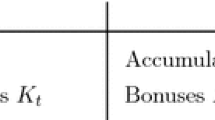Abstract
This article provides an integrated analysis of pension funding and corporate financing strategies in the presence of default risk. The article shows that when the marginal personal income tax rate is constant, the financing decision with respect to pension funding is influenced entirely by tax considerations. When the marginal personal income tax is progressive, the optimal financing of pension funding depends on the cyclical nature of the firm (as characterized by the sign of beta), the riskiness of pension assets, and ERISA regulations concerning the pension-benefit guaranty rate, the marginal pension insurance premium and the firm's legal responsibility for its unfunded pension obligations. It is shown that a necessary condition for partial pension funding is that the marginal insurance premium imposed by PBGC must be less than actuarially fair, and a necessary condition for pension funding to be financed by both debt and equity is that beta must be positive.
Similar content being viewed by others
References
Alderson, M. and C. F. Lee, “Corporate Pension Policy and Capital Structure Decision,” Journal of Economics and Business 40, 209–228 (1988).
Ang, J. and T. Lai, “On Optimal Pension Funding Policy,” Journal of Economics and Business 40, 229–38 (1988).
Arnott, R. and M. Gersovitz, “Corporate Financial Structure and the Funding of Private Pension Plans,” Journal of Public Economics 13, 231–47 (1980).
Berheim, D. and J. Shoven, “Pension Funding and Saving,” in Z. Bodie, J. Shoven and D. Wise (eds.) Pensions in the U.S. Economy, Chicago, The University of Chicago Press, 85–113 (1988).
Bicksler, J. and A. Chen, “The Integration of Insurance and Taxes in Corporate Pension Strategy,” The Journal of Finance 40, 943–55, (July 1985).
Black, F., “The Tax Consequences of Long-Run Pension Policy,” Financial Analysis Journal 36, 21–28 (1980).
Bullow, J. and M. Schole, “Who Owns the Assets in a Defined-Benefit Pension Plan?” in Z. Bodie and J. Shoven (eds.) Financial Aspects of the United States Pension System, Chicago, The University of Chicago Press, 1983.
De Angelo, H. and R. Masulis, “Leverage and Dividend Irrelevancy Under Corporate and Personal Taxation,” Journal of Finance 35, 453–64 (May 1980).
Feldstein, M.S. and S. Seligman, “Pension Funding, Share Prices and National Saving,” Journal of Finance 36, 801–24 (1981).
Harrison, J. and W. Sharpe, “Optimal Funding and Asset Allocation Rules for Defined Benefit Pension Plans,” in Z. Bodie and J. Shoven (eds.) Financial Aspects of the United States Pension System, Chicago, The University of Chicago Press, 1983.
Hu, S.C., “The Growth of Pension Saving,” in P.H. Hendershott (ed.), The Level and Composition of Household Saving, Cambridge, Ballinger, 1985.
Hu, S.C., “Pensions in Labor Contracts,” International Economic Review 29, 477–92 (1988).
Ippolito, R.A., Pensions, Economics and Public Policy, Homewood, Dow Jones-Irwin, 1986.
Ippolito, R.A., “A Study of Regulatory Effect of the Employee Retirement Income Security Act,” Journal of Law and Economics 31, 85–125 (1988).
Kovenock, D. and R. Sparks, “An Implicit Contract Approach to Employee Stock Ownership Plans,” Journal of Comparative Economics 14, 425–51 (1990).
Lacker, J. R. Levy and J. Weinberg, “Incentive Compatible Contracts, Asset Prices and the Value of the Firm,” Journal of Financial Intermediation 1, 31–56 (1990).
McMillan, H.M., “Nonassignable Pensions and the Price of Risk,” Journal of Money, Credit and Banking 18, 60–75 (February 1986).
McMillan, H.M., “A Principal-Agent Analysis of Pension Policy,” Managerial and Decision Economics 8, 313–19 (1987).
Miller, M., “Debt and Taxes,” Journal of Finance 32, 261–75 (December 1977).
Miller, M., “The Modigliani-Miller Proposition after Thirty Years,” Journal of Economic Perspective 2, 99–120 (1988).
Ross, S.A., “Debt and Taxes under Uncertainty,” Journal of Finance 40, 637–58 (July 1985).
Sharpe, W., “Corporate Pension Funding Policy,” Journal of Financial Economics 3, 183–93 (1976).
Tepper, I., “Taxation and Corporate Pension Funding Policy,” Journal of Finance 36, 1–13 (1981).
Townsend, R., “Optimal Contracts and Competitive Markets with Costly Verification,” Journal of Economic Theory 21, 265–93 (1979).
Utgoff, K., “Changes in Pension Regulation,” Regulation 13, 29–38 (1990).
Wilkie, R., 1988 Pension Handbook, Paramus, NJ, Prentice Hall, 1988.
Author information
Authors and Affiliations
Rights and permissions
About this article
Cite this article
Hu, S.C. Corporate capital structure and pension-funding strategy. Rev Quant Finan Acc 2, 145–168 (1992). https://doi.org/10.1007/BF00243799
Issue Date:
DOI: https://doi.org/10.1007/BF00243799




